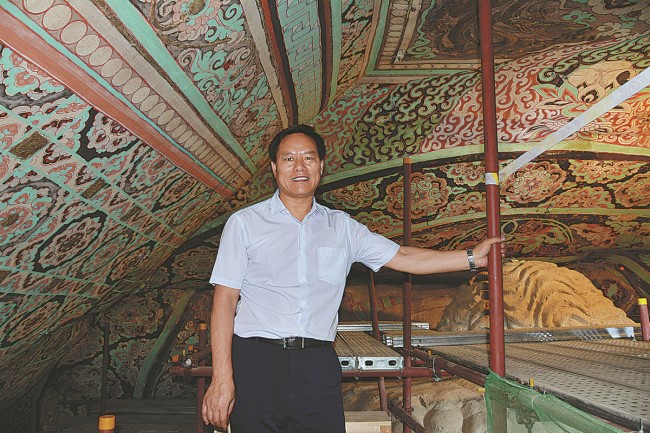Researchers protect Mogao Grottoes

Wang Wanfu in one of the Mogao Grottoes in Dunhuang, Gansu province. [Photo provided to China Daily]
Over the past 30 years, Wang Wanfu has been working at Dunhuang Academy, trying to protect the Mogao Grottoes in Dunhuang, Northwest China's Gansu province, from damage caused by sand and wind.
Sitting at the foot of Mingsha Hill on the southeastern edge of the Kumtag Desert, one of the largest deserts in China, the 1,600-year-old grottoes have been under constant threat of such damage.
In May 1900, Taoist priest Wang Yuanlu accidentally discovered thousands of rolls of Buddhist sutras at the Library Cave, the No 17 Grotto, when he tried to clean up accumulated sand that buried the cave's entrance. Today, visitors can still see the scars that the sand has left on the walls at the entrance.
In the early 1990s, when Wang Wanfu was just starting his career at the site, he noticed that one of his older colleagues always covered his head with a scarf. "Once wind blew, sand would fill the air," said the 56-year-old, who is now director of the department of conservation research at the Dunhuang Academy. "Now, the situation has been obviously improved."
What once worried people the most was that the Mingsha Hill, also known as the Singing Sands Hill, would constantly shift forward 10 meters every year, which would ultimately bury the Mogao Grottoes.
Wang and his colleagues found that around the site, the wind blows mainly from three directions; northeast, northwest and south. Winds from the northwest and south are more frequent, but those from the northeast are more powerful, he said. "Actually, the hill is moving back and forth. In some seasons, it moves eastward, and in others westward, but it's generally stable, so the Singing Sands Hill is unlikely to bury the Mogao Grottoes," Wang said.
Wind erosion is also a major problem that the caves are confronted with. The grottoes were built in the face of a cliff. Wind carrying sand sweeps the slope of the hill and, in the long run, will erode the tops of the upper caves. One example is the No 460 Grotto, whose roof has been cracked.
Another big challenge are the minute sand particles invisible to the naked eye carried along by the wind, which have sharp corners and edges that cut into the surfaces of murals, degrading the colors. When the flying dust falls into the cracks of the paintings, they accelerate the peeling process, Wang said.
To reduce damage caused by wind and sand, Wang and his colleagues have done a lot of research and have established a comprehensive treatment system. As part of the system, the researchers have built belts of shrubs and have placed stones of various sizes on the sand to reduce the amount blown by winds. With the help of the comprehensive treatment system, sands entering the caves have been reduced by more than 85 percent, Wang said.
In 2018, the wind and sand treatment comprehensive system applied at the grottoes as a part of the Aeolian sand disaster prevention program won second prize of the State Scientific and Technological Progress Award.
-
As AI encounters Dunhuang's art, the ancient caisson ceiling bridges centuries to the present.
View all stories

 Gansu thrives from green development
Gansu thrives from green development  >
>